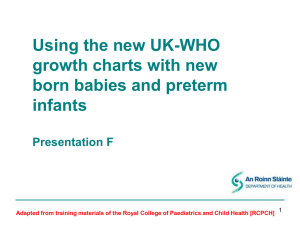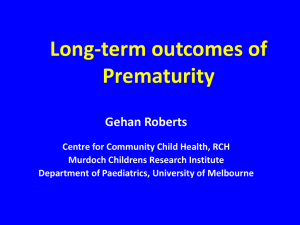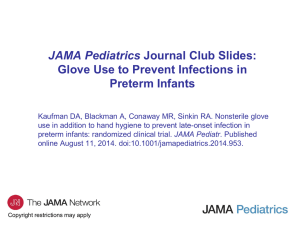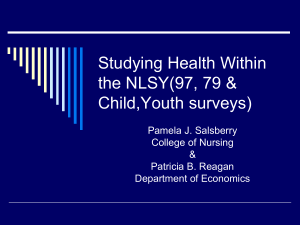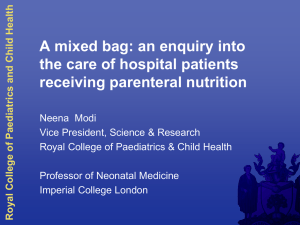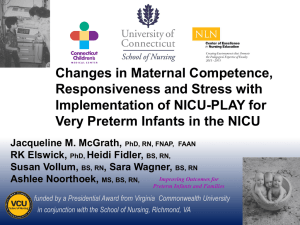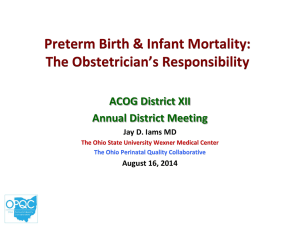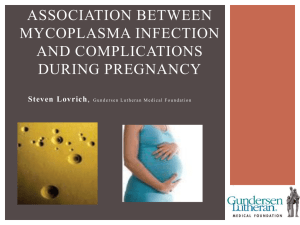The Late Preterm Infant
advertisement
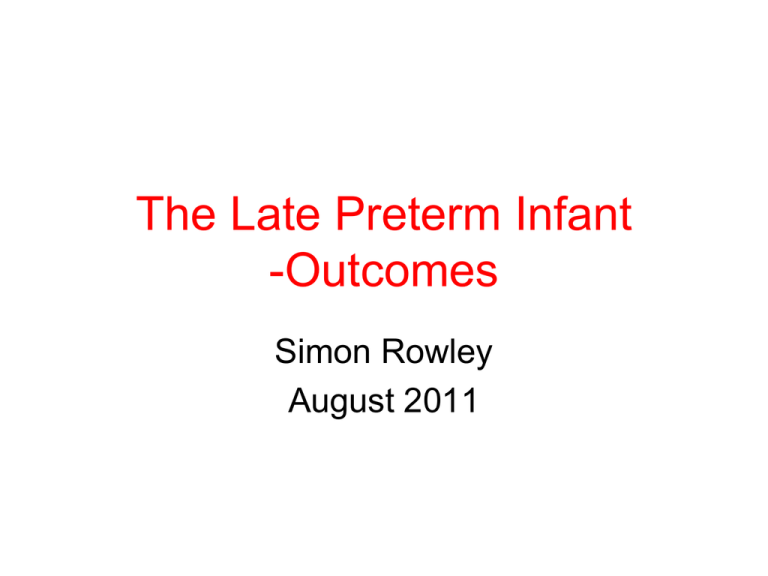
The Late Preterm Infant -Outcomes Simon Rowley August 2011 Who is the late preterm? • 34 weeks 0 days through 36 weeks 6 days after last menstrual period • The lower limit used because it is a frequent cut-off point for obstetric decision making and as a criteria for admission to a level 2 or level 3 NICU Overview of talk • • • • • • • • • The rise in Preterm rates Physiological changes in the last weeks of pregnancy Morbidities in the late preterm infant Short term outcomes -respiratory Long-term developmental and behavioural outcomes in the preterm infant Long term cardiovascular and diabetes risk Costs to society Implications for obstetric practice Parents perceptions of illness severity in their baby Complications of the Late Preterm Infant – Darcy J Perinat Nursing Vol 23 No 1 PP 78-86. 2009 • The incidence of prematurity continues to rise • Late preterm infants (34-36 wks) comprise the fastest growing population and account for more than 70% of all preterm births and 8.5% of all births in the USA(2005) • Generally less studied as a group • Morbidity and mortality higher than expected • The newborn risk in late preterm population is under appreciated Survival AT NWH 1959-2003 Late preterm admissions ACH NICU 2004-2008 • • • • 4169 total admissions 1185 infants admitted 34-36weeks this is 28.5% of total admissions RDS the main diagnosis other than prematurity National Institute of Child Health and Human Development Workshop July 2005 –Tonse, Raju et al. Pediatrics 2006;118;1207-1214 • Preterm births in US ↑ 9.1% in 1981 to 12.3% in 2003 • Most of the increase is in proportion of late preterm births (Davidoff et al Semin Perinatol 2006) • Underscored the need to educate healthcare providers and parents about the vulnerability of late preterm infants • ‘These infants need diligent evaluation, monitoring, referral, and early return appointments not only for post-natal evaluation but also for continued long term follow-up’ Increase in Late Preterm births • Increased reproductive technology and multi-fetal pregnancies • Advance in obstetric practice with increased surveillance and medical interventions in pregnancy • electronic fetal monitoring increased between 19892003 from 68-85% and labour inductions and LSCS increased correspondingly • Changing maternal profile –teenage mothers, increasing maternal age, obesity, gestational diabetes • Possible approach of clinicians to the late preterm infant as being similar to the term infant post-natally What happens to the late preterm infant after birth? • Resuscitation • Transition • Separation from parents • Admission to NICU • Invasive procedures • Respiratory support • Phototherapy Developmental and Physiological Immaturity of Late Preterm Infants 1 • From 34.0-36.9 weeks gestation • Terminal respiratory units-alveolar saccules become lined with cuboidal type 2 and flat type 1 epithelial cells become mature alveoli lined with extremely thin type 1 alveolar cells • Pulmonary capillaries bulge into each terminal sac • Adult pool sizes of surfactant attained Developmental and Physiological Immaturity of Late Preterm Infants 2 • Apnoea incidence 4-7% (less than 1% at term) • Mechanism –central -the brain is developmentally less mature with fewer sulci and gyri and less myelin. The brain at 34 weeks is approximately 2/3 size at term • -other - ↓ susceptibility to hypoxic resp. depression, ↓chemo-sensitivity to CO2, ↑resp.inhibition sensitivity to laryngeal stimulation, ↓ upper airway dilator muscle tone (all these are SUDI risks) Developmental and Physiological Immaturity of Late Preterm Infants 3 • Cardiovascular structural and functional immaturity restricts reserve during stress. • Delayed ductal closure and persistent pulmonary hypertension(or delayed transition) more likely • Brown fat accumulation, maturation and accumulation of hormones resposible for brown fat metabolism ( prolactin, leptin, NA, T3, cortisol) peak at term • Less white adipose tissue, cannot generate heat as effectively from brown adipose tissue as effectively as term infants • Larger SA/body weight ratio increases heat loss Developmental and Physiological Immaturity of Late Preterm Infants 4 • Hypoglycaemia inversely proportional to gestational age • Glycogen stores double at 36w gestation, in preparation for birth, and are rapidly depleted within the first 24 hours of life • Immature hepatic glycogenolysis, adipose tissue lipolysis, hormonal dys-regulation, deficient hepatic gluco-neogenesis and keto-genesis • Therefore blood glucose drops to nadir at 1-2 hours until alternative pathways activated or exogenous glucose supplied Developmental and Physiological Immaturity of Late Preterm Infants 5 • Jaundice more common. Late preterms 2 times more likely to have significantly elevated SBR and persisting 5-7 days • Lower concentrations of UDPG glucuronosyltransferase • Enterohepatic circulation secondary to delayed gut motility and feeding • Risk of kernicterus increased at lower gestations • Hyperbilirubinaemia the most common reason for re-admission Do Late Preterm Infants Breast Feed? Australian longitudinal study: Donath et al. Arch Dis Child Fetal Neonatal Ed 2008.93.448-450 • 35-36 weeks 88.2% breast feeding initiation rate • 41% still breast feeding at 6 months age • 37-39 weeks 92.0% initiation rate • 54.5% still breast feeding at 6months • Term infants 93.9% initiation rate • - 60.5% still breast feeding at 6 months Kernicterus in Late Preterm Infants Cared for as Term Healthy Infants. Bhutani, Semin Perinatol 2006; 30:89-97 Kernicterus Registry Incidence & Patient Profile 125 cases in US, 1979 – 2002 “healthy at discharge” Sources – parents, MDs RNs, literature, med-legal 69% male Nearly all breastfed [follow up scheduled for 2 weeks] 97% discharge <72 h (58% < 48 h) 25% Late Preterm infants LGA with kernicterus 35% Late Preterm infants were LGA* 25% Term infants were LGA* The contribution of Mild and moderate Preterm birth to Infant mortality Kramer et al JAMA vol 284 no 7 Aug 16 2000 • Landmark study • Looked at quantitative contribution of mild (34-36) preterm birth to infant mortality • Large cohort of US and Canadian births for years 1985 and 1995 (US) and 1985-7 and 1992-4 (Canada) • RR for deaths from all causes at 34-36 wks gestation was 2.9 (CI 2.8-3.0) in US and 4.5 ( CI 4.0-5.0) in Canada • Early neonatal, late neonatal and post neonatal deaths contributed 9/1000 livebirths • Postnatal causes included infection,SIDS and external causes( NAI and accidental deaths) Perinatal Outcomes Associated with Preterm Birth at 33 to 36 Weeks’ Gestation: A Population-Based Cohort Study : Khasu et al Pediatrics 2009; 123 Respiratory Morbidity and Lung Function in Preterm Infants of 32 to 36 Weeks’ gestational Age Colin et al Pediatrics 2010;115-128 • Comprehensive search for studies reporting epidemiologic data and respiratory morbidity in infants 34-36 weeks • 24 studies identified • Consistent finding that babies born at 34-36 weeks experience substantial respiratory morbidity compared with term infants. • Levels of morbidity at times equalled that of very preterm infants • Longitudinal studies indicate that this reduced level of pulmonary function early on persists into early adulthood Decreased expiratory flow in infants who were healthy late preterms Colin et al Pediatrics 2010; 126: 115-128 Respiratory Morbidity and Lung Function in Preterm Infants of 32 to 36 Weeks’ gestational Age Colin et al Pediatrics 2010;115-128 Short Term Outcomes of Infants Born at 35 and 36 Weeks Gestation: We Need to Ask More Questions. Escobar et al. Semin Perinatol 30:2833 2006 NWH Data RDS incidence related to gestation in late preterm infants • 33-34 weeks • 35-36 weeks • Term 12% 2% 0.11% Risk of respiratory morbidity in term infants delivered by elective LSCS: cohort study Hansen et al. BMJ Online March 2008 • 2687 infants out of total 34458 delivered by elective LSCS in years 1998-2006 • Main outcome respiratory morbidity (TTN, RDS, PPHTNB, serious resp. morbidity (oxygen more than 2 days, CPAP or IPPV) in LSCS compared to vaginal delivery • At 37 wks ↑ resp morbidity OR 3.9(2.4-6.5) • At 38 wks resp morbidity OR 3.0( 2.1-4.3) • At 37 wks serious morbidity ↑ 5 fold OR 5.0(1.6-16) • Results unchanged after exclusion of pregnancies complicated by diabetes, pre-eclampsia IUGR, or breech Incidence of Early Neonatal Mortality and Morbidity After Late Preterm and Term Cesarian Delivery De Luca et al Pediatrics vol 123 no. 6 2009 • GA specific risk estimates are lowest between 38-40 weeks and should be included in the consent process • Elective cesarian delivery is consistently associated with increased intrapartum and neonatal mortality, risk of admission, and respiratory morbidity compare to planned vaginal delivery • No advantage of PVD over emergency cesarian delivery Incidence of Early Neonatal Mortality and Morbidity After Late Preterm and Term Caesarian Delivery De Luca et al Pediatrics vol 123 no. 6 2009 Special Care admissions Incidence of Early Neonatal Mortality and Morbidity After Late Preterm and Term Caesarian Delivery De Luca et al Pediatrics vol 123 no. 6 2009 Respiratory morbidity Incidence of Early Neonatal Mortality and Morbidity After Late Preterm and Term Caesarian Delivery De Luca et al Pediatrics vol 123 no. 6 2009 Elective Cesarian vs Planned Vaginal Delivery Getting evidence into obstetric practice; appropriate timing of caesarian section Nicholl and Cattell Australian Health review 2010,34,90-92 • Aim: to reduce rate of term elective CS with no medical indication before 39 completed weeks, from 30% to 10% of all term elective CS (both private and public) over a 6 month period in 2007 • Method: multidisciplinary project formed to investigate the extent of the problem and work out the intervention which was essentially pre-emptive education of all midwifery and obstetric staff and provision of evidence folders in key clinical areas Perinatal Outcomes Associated with Preterm Birth at 33 to 36 Weeks’ Gestation: A Population-Based Cohort Study : Khasu et al Pediatrics 2009; 123
